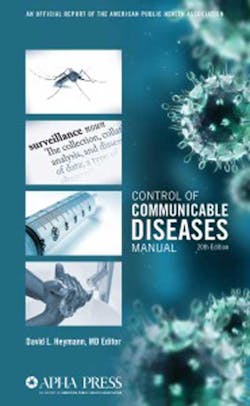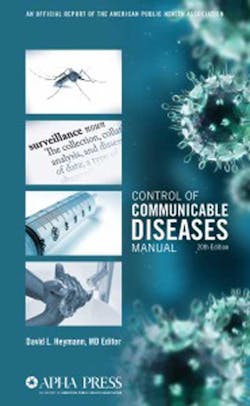Control of communicable diseases, with an emphasis on Ebola-Marburg viral diseases
As updates about the Ebola outbreak continue to make headlines, The American Public Health Association (APHA) has published the 20th edition of its “Control of Communicable Diseases Manual” as a key resource for public health professionals fighting infectious disease.(1)
Here is information for ordering the book: published by APHA Press, “Control of Communicable Diseases Manual, 20th Edition,” ISBN 978-0-87553-018-5, softcover, 750 pages, list price is $50 plus shipping and handling (APHA member price is $35). To order, call 888-320-APHA, fax 888-361-APHA, email APHA press, or visit the APHA Bookstore.
In advance of the book’s release and in response to the emerging Ebola outbreak, APHA has made the Ebola-Marburg virus chapter of CCDM available online as a free download to help public health workers respond to the disease.(2) In the full edition, all 138 chapters have been updated with the latest information about the occurrence, transmission, resistance, and control of infectious diseases. Three diseases included in previous editions – Japanese encephalitis, West Nile virus, and Rift Valley fever – have now been given their own chapters based on their increasing importance. After I downloaded the chapter in Adobe format I found that a password was required to open the document, which I did not have. I used the print feature and was able to save the document in Adobe format.
The ADA Division of Science advises dental professionals not to treat dental patients if they have signs or symptoms of Ebola, as most oral health providers do not have the appropriate equipment, experience, or skills to safely treat an Ebola patient. The most common signs and symptoms of Ebola infection are fever (greater than 38.6˚C or 101.5˚F), severe headache, muscle pain, vomiting, diarrhea or stomach pain, or unexplained bleeding or bruising. As with all patients, dental professionals should take thorough medical histories of patients, including a travel history from those with symptoms in which viral infection is suspected. There are specific questions suggested to be included into a health questionnaire.(3)
Noel Kelsch, RDHAP, BS, wrote an informative article on DentistryIQ.(4) She explains that there is a screening tool, for initial assessment and management of returning travellers from areas affected by Ebola, for dental offices and allied health professionals, courtesy of Public Health Ontario. (5)
Become informed, and do not panic. The Ebola virus disease (EVD) is spread through close contact with the blood, secretions, organs, or other bodily fluids of infected animals. Human-to-human transmission is through direct contact with broken skin or mucous membranes, blood, secretions, organs, or other bodily fluids such as the saliva of infected people. Indirect contact with environments contaminated with such fluids is also a route of transmission. To date, transmission through the air has not been documented, and there have not been any case reports of transmission in dental settings or through saliva contamination.
Maria Perno Goldie, RDH, MS, is the editorial director of RDH eVillage FOCUS.
References
1. http://www.apha.org/news-and-media/news-releases/book-news-releases/new-CCDM-edition.
2. http://www.apha.org/~/media/files/pdf/pubs/ccdm_ebola.ashx.
3. http://www.ada.org/en/member-center/oral-health-topics/ebola-resources.
4. http://www.dentistryiq.com/articles/2014/10/ebola-dental-professionals-need-to-be-prepared-for-all-emerging-diseases.html.
5. http://www.publichealthontario.ca/en/eRepository/EVD_screening_tool_dental_allied_health_professionals.pdf.





